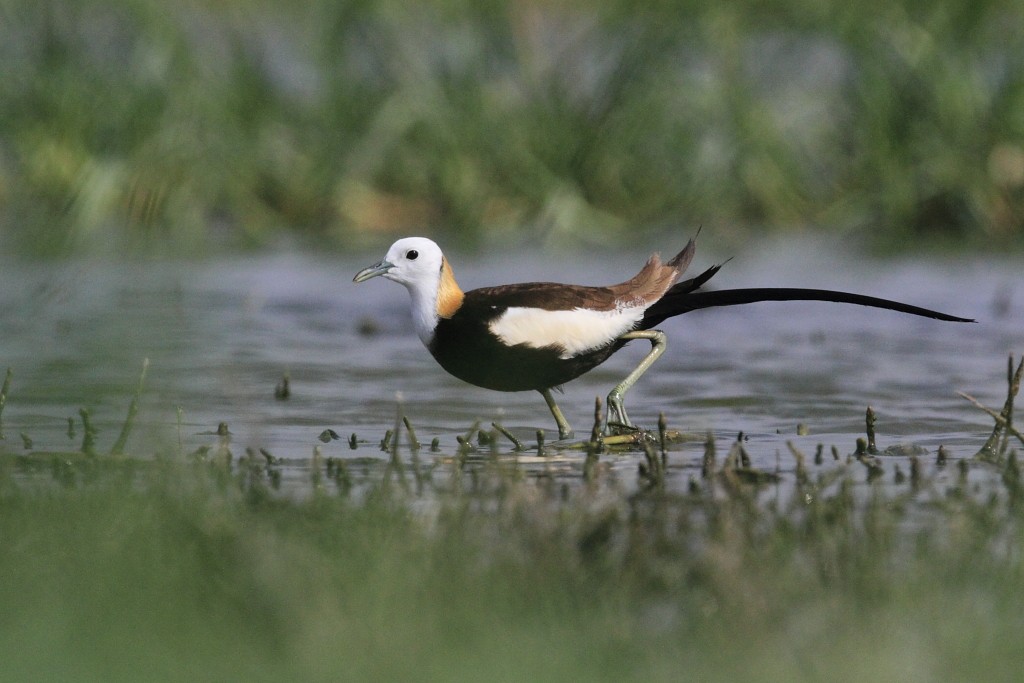Pheasant-tailed Jacana
A species of Pheasant-tailed Jacana Scientific name : Hydrophasianus chirurgus Genus : Pheasant-tailed Jacana
Pheasant-tailed Jacana, A species of Pheasant-tailed Jacana
Botanical name: Hydrophasianus chirurgus
Genus: Pheasant-tailed Jacana
Content
Description General Info
 Photo By Karunakanth , used under CC-BY-SA-4.0 /Cropped and compressed from original
Photo By Karunakanth , used under CC-BY-SA-4.0 /Cropped and compressed from original Description
The pheasant-tailed jacana is conspicuous and unmistakable. It is the longest species in the jacana family when the tail streamers are included. This is the only jacana to have a different breeding and non-breeding plumages. The breeding plumage is marked by the elongated central tail feathers that given the bird its name. The body is chocolate brown, with a white face and the back of the crown is black with white stripes running down the sides of the neck that separate the white of the front of neck and the silky golden yellow of the nape. The wings are predominantly white. In flight the white wing shows a black border formed by black on the outermost primaries and the tips of the outer secondaries and the primaries. The wing coverts are pale brown and the scapulars may be glossed green or purple. In the non-breeding season the top of the head and back are dark brown and only a trace of the golden nape feathers may be seen. A dark eyestripe runs down the sides of the neck and forms a dark necklace on a slightly sullied white front. The outer two primaries have a slender (lanceolate or spatulate) extension that broadens at the tip. The fourth primary has an acute tip formed by the shaft after the loss of webbing. Young birds have brown upper parts and the dark necklace is broken. Some traces of the black stripe on the side of the neck and white wings separate them from somewhat similar looking immatures of the bronze-winged jacana. They have strongly developed sharp white carpal spurs which are longer in females. The spurs may also undergo moult but has not been specifically described in this species. The tail is short and strongly graduated. The bill is more slender than in the bronze-winged and is bluish-black with a yellow tip when breeding and dull brown with yellowish base when not breeding. The leg is dark bluish grey and the iris is brown. Shufeldt described the skeletal features of a specimen from Luzon as being typical of jacanas but that the skull resembles in some ways to those of sandpipers. The skull and mandibles are slightly pneumatized unlike other bones and the sternum has a notch on the side which serve as attachment points to long and slender xiphoidal processes. 
Size
58 cm
Colors
Brown
Black
Yellow
Gold
Gray
White
Nest Placement
Floating
Feeding Habits
Pheasant-tailed Jacana primarily feed on insects, mollusks, and other invertebrates, often foraging on vegetation or the water’s surface. They forage by walking or swimming, occasionally ingesting algae, seeds, and plant material, likely by accident.
Habitat
Pheasant-tailed Jacana thrives in diverse freshwater wetlands across tropical and subtropical regions, from broad lowland lakes to reservoirs and rice paddies rich in floating aquatic plants like lotus and water-lilies. This species selectively breeds in habitats with ample floating vegetation and is known to ascend to high-altitude wetlands in the Himalayas during summer. While generally sedentary, some populations exhibit migratory behavior, dispersing to locations such as Southeast Asia and Taiwan, where it's considered endangered.
Dite type
Omnivorous
General Info
Feeding Habits
Bird food type
Behavior
The pheasant-tailed jacana's main sources of food are insects, molluscs, and other invertebrates picked from the floating vegetation or the water's surface. The forage by walking on vegetation and also by swimming in water, somewhat like phalaropes (Hoffmann claims that they wade in deeper water but never swim). They also ingest filamentous algae, seeds and plant material but this may be purely accidental. Flocks of as many as 50 to 100 can be found on a waterbody and they can become very tame and habituated to human presence. They usually fly low over the water surface but may also mob raptors higher in the air and on landing, keep their wings open until they find firm footing. The typical call is a mewing me-onp or a nasal teeun among winter flocks. Males and females have different calls during the breeding season and several contextual variants exist. Young birds produce a low cheep with the bill closed. 
Distribution Area
The pheasant-tailed jacana is a resident breeder in tropical India, Southeast Asia, and Indonesia and it overlaps greatly with the range of the bronze-winged jacana but unlike the bronze-winged jacana, this species is found in Sri Lanka. It is found on small to large lakes having sufficient floating vegetation on them. It is sedentary in much of its range, but northern breeders from south China and the Himalayas migrate south of their ranges to Southeast Asia and Peninsular India respectively. In Nanking, the birds leave in November and return in summer in the third week of April. Some birds arrive in the non-breeding plumage. It is also resident in Taiwan, where it is considered endangered. Birds disperse in summer and have been recorded as vagrants in Socotra, Qatar, Australia and southern Japan. The species tends to be commoner in lower elevations but they climb into the Himalayas in summer and records exist of the species from altitudes of 3650 m in Kashmir (Vishansar Lake) and 3800 m in Lahul. 
Species Status
Not globally threatened.
Scientific Classification
Phylum
Chordates Class
Birds Order
Shorebirds Family
Jacanas Genus
Pheasant-tailed Jacana Species
Pheasant-tailed Jacana